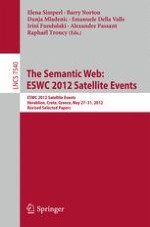2015 | Buch
The Semantic Web: ESWC 2012 Satellite Events
ESWC 2012 Satellite Events, Heraklion, Crete, Greece, May 27-31, 2012. Revised Selected Papers
herausgegeben von: Elena Simperl, Barry Norton, Dunja Mladenic, Emanuele Della Valle, Irini Fundulaki, Alexandre Passant, Raphaël Troncy
Verlag: Springer Berlin Heidelberg
Buchreihe : Lecture Notes in Computer Science
